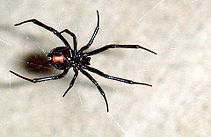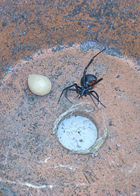Black widow spider
2008/9 Schools Wikipedia Selection. Related subjects: Insects, Reptiles and Fish
| Black widow | ||||||||||||
|---|---|---|---|---|---|---|---|---|---|---|---|---|
 |
||||||||||||
| Scientific classification | ||||||||||||
|
||||||||||||
| Species | ||||||||||||
|
L. mactans Fabricius, 1775 |
The black widow spider is a group of spiders which includes the southern black widow (Latrodectus mactans), the northern black widow (L. variolus), and the western black widow (L. hesperus). As the name indicates, the southern widow is primarily found in (and is indigenous to) the southeastern United States, ranging from Florida to New York, and west to Texas, Oklahoma and Arizona, where they run particularly rampant. The northern black widow is found primarily in the northeastern United States and southeastern Canada (only on the Bruce Peninsula), though its ranges overlap that of L. mactans quite a bit. The western widow is found in the western United States, as well as in southwestern Canada and much of Mexico. There have been incidents in Sweden and Denmark with black widow spiders being found in cars imported from the southern U.S.
Prior to 1970, when the current taxonomic divisions for North American black widows were set forth by Kaston, all three varieties were classified as a single species, L. mactans. As a result, there exist numerous references which claim that "black widow" (without any geographic modifier) applies to L. mactans alone. Since common usage of the term "black widow" makes no distinction between the three species (and many people are unaware of the differences between them), and because the three species have much in common, this article treats all three species of black widow equally. Except where otherwise indicated, the remainder of the article applies to all three of the above species.
Prey
Black widow spiders typically prey on a variety of insects, but occasionally they do feed upon woodlice, diplopods, chilopods and other arachnids. When the prey is entangled by the web, L. mactans quickly comes out of its retreat, wraps the prey securely in its strong web, then stabs and envenomates its prey. The venom takes about ten minutes to take effect; in the mean time, the prey is held tightly by the spider. When movements of the prey cease, digestive enzymes are released into the wound. The black widow spider then carries its prey back to its retreat before feeding.
Reproduction
When a male is mature, he spins a sperm web, deposits semen on it, and charges his palpi with the sperm. Black widow spiders reproduce sexually when the male inserts his palpus into the female's spermathecal openings. The female deposits her eggs in a globular silken container in which they remain camouflaged and guarded. A female black widow spider can produce four to nine egg sacs in one summer, each containing about 100-400 eggs. Usually, eggs incubate for twenty to thirty days. Rarely do more than a hundred survive through this process. On average, thirty will survive through the first molting, because of cannibalism, lack of food, or lack of proper shelter. It takes two to four months for black widow spiders to mature enough to breed, however full maturation typically takes six to nine months. The females can live for up to five years, while a male's lifespan is much shorter. Contrary to popular belief, the female only rarely eats the male after mating, and L. mactans is the only black widow species for which this form of sexual cannibalism has been observed in the wild. Lifespans depend upon environment, with shelter being the greatest determining factor and food the second greatest. Males that escape being consumed by the females can go on to fertilize other females. This is a general misconception, as the name seems to suggest that the males are invariably consumed after mating.
Natural enemies
There are various parasites and predators of widow spiders in North America, though apparently none of these have ever been evaluated in terms of augmentation programs for improved biocontrol. Parasites of the egg sacs include the flightless scelionid wasp Baeus latrodecti, and members of the chloropid fly genus Pseudogaurax. Predators of the adult spiders include a few wasps, most notably the blue mud dauber, Chalybion californicum, and the spider wasp Tastiotenia festiva. Other species will occasionally and opportunistically take widows as prey, but the preceding all exhibit some significant specific preference for Latrodectus.
Venom
Although their venom is extremely potent, (15 times more potent than that of the rattlesnakes; it is also reported to be much more potent than the venom of cobras and coral snakes), these spiders are not especially large. Compared to many other species of spiders, their chelicerae are not very large or powerful. In the case of a mature female, the hollow, needle shaped part of each chelicera, the part that penetrates the skin, is approximately 1.0 millimeters (about .04 in) long, long enough to inject the venom to a point where it can be harmful. The males, being much smaller, inject far less venom with smaller chelicerae. The actual amount injected, even by a mature female, is very small in physical volume. When this small amount of venom is diffused throughout the body of a healthy, mature human, it usually does not amount to a fatal dose (though it can produce the very unpleasant symptoms of latrodectism). Deaths in healthy adults from Latrodectus bites are relatively rare in terms of the number of bites per thousand people. Sixty-three deaths were reported in the United States between 1950 and 1990. On the other hand, the geographical range of the widow spiders is very great. As a result, far more people are exposed, world-wide, to widow bites than are exposed to bites of more dangerous spiders, so the highest number of deaths world-wide are caused by members of their genus. Widow spiders have more potent venom than most spiders, and prior to the development of antivenin, 5% of reported bites resulted in fatalities. The venom can cause a swelling up to 15 cm. Improvements in plumbing have greatly reduced the incidence of bites and fatalities in areas where outdoor privies have been replaced by flush toilets.
There are a number of active components in the venom:
- Latrotoxins
- A number of smaller polypeptides - toxins interacting with cation channels which display spatial structure homology - which can affect the functioning of calcium, sodium, or potassium channels.
- Adenosine
- Guanosine
- Inosine
- 2,4,6-trihydroxypurine.
The venom is neurotoxic.
